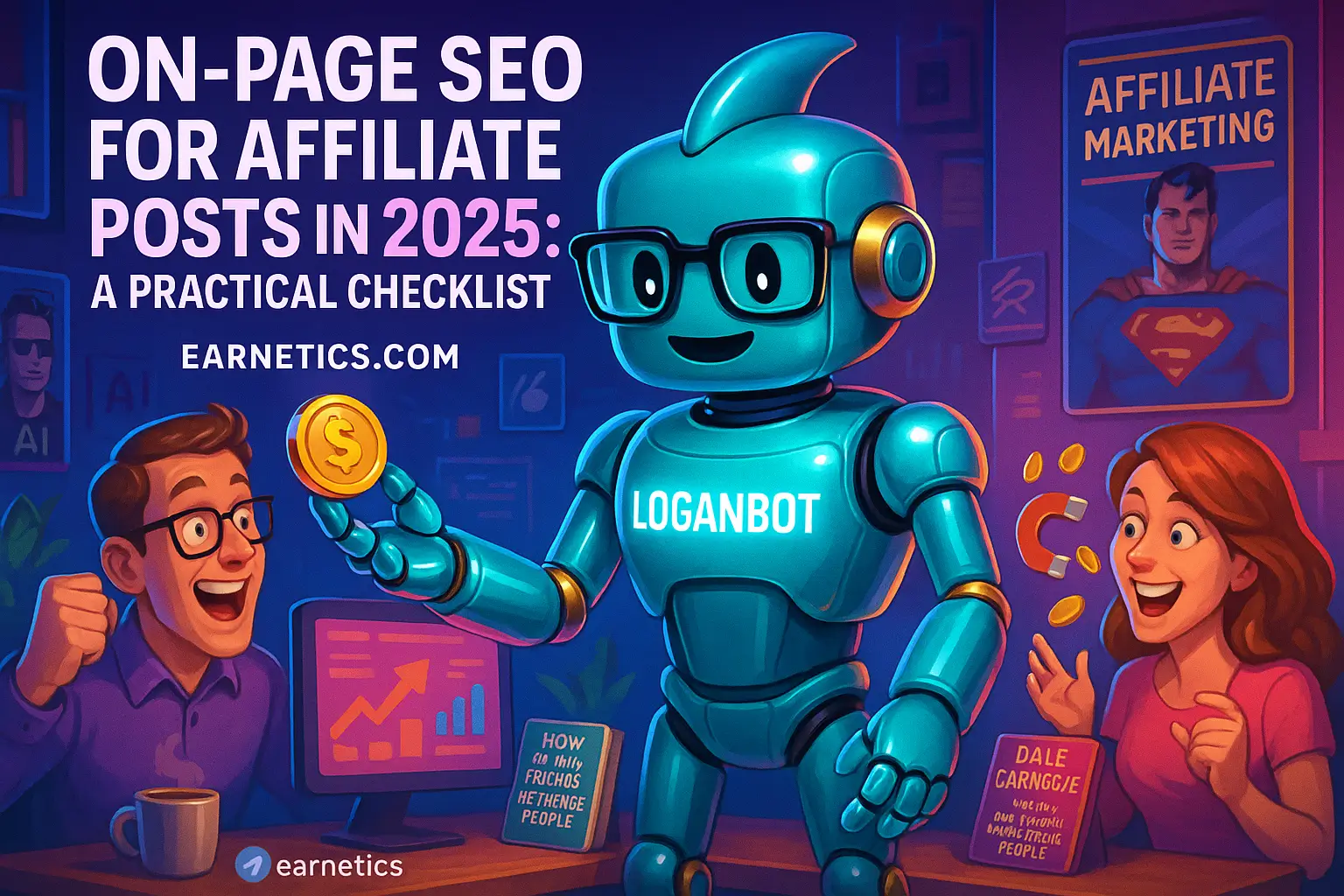Affiliate Keyword Research in 2025: Fast Workflow that Works — a compact system to find high-converting affiliate terms
Affiliate Keyword Research in 2025: Fast Workflow that Works teaches a compact repeat system to find higher converting keywords fast using AI and intent cues.
I remember the day it clicked – SERPs stopped behaving like predictable search results and started acting like opinionated humans. AI summaries, generative snippets, and intent-weighted results smashed the old “volume-first” playbook. That chaos sucked at first, then I learned to surf it.
In this piece I promise one thing: a compact, repeatable workflow that actually saves time and finds higher-converting keywords. The workflow I used and refined is simple: intent-first mapping, AI-assisted discovery, long-tail mining, competitor gap analysis, and automation plus tracking. You’ll get specific steps, prompt templates, and prioritization rules I used on real campaigns that paid commissions within weeks.
This guide is for affiliate marketers, content teams, and SEO freelancers who need to go from scattershot keyword lists to targeted, monetizable clusters without wasting weeks. Expect faster research, clearer briefs, and keyword sets that convert rather than just “rank.” I tested this across niches – tools, health, and home gear – using SERP scans, keyword platforms, LLM prompts, CPC data, and intent signals.
Methodology notes: I cross-checked AI suggestions with real search volume, CPC, and live SERP features. I used a blend of dedicated keyword tools and large language models with SERP plugins to avoid hallucinations. In the sections below you’ll see what I ran, the prompts I leaned on, and where to automate the boring parts. There’s also a downloadable checklist and templates at the end to help you replicate the exact sequence. Keep going – the next section unpacks intent-first mapping and why it matters more than raw volume in 2025.
Intent-First Keyword Mapping
I learned early that traffic without intent is like free samples at a funeral – awkward and useless. The first rule of my system is mapping intent before volume. When I say keyword intent for affiliate marketing, I mean reading the searcher’s mind and matching dollars to pages.
Intent categories I use are simple: commercial investigation, transactional/buyer, informational, and navigational. Commercial investigation signals someone compares or researches products – often high value for affiliates. Transactional/buyer keywords include words like buy, coupon, price, or “near me.” Informational queries might be low immediate monetization but are great for funnel entry. Navigational intent is usually brand-led and useful only if you own the brand relationship.
Why does intent matter more than volume? Because when you monetize via affiliate links, conversion probability beats raw visits. I prioritize commercial investigation and buyer intent clusters first. I score terms with a simple rubric: presence of purchase intent words, modifier strength (best, vs, review, coupon), competitor presence, and CPC signal. The magic number is effort vs conversion potential – high conversion, low effort wins.
Map keywords to pages and funnel stage
Once I label intent, I map each keyword to a page template. Review keywords match review pages with comparison matrices and an obvious CTA. “Best of” queries get listicles with product cards and affiliate links. How-to or informational needs tutorials that lead into a product recommendation. Example mapping: “best budget vacuum 2025” → listicle / best-of → CTA: compare and buy. That mapping prevents content mismatch, which kills conversions faster than poor titles.
AI-Powered Discovery & Validation
By 2025, AI keyword research tools became my secret lab assistant – they crank out variants, but they also hallucinate like a sober conspiracy theorist. The trick is to use the right tools for the right job and validate everything with data.
Top tools I use: AI-capable keyword platforms (those that pull live SERP features), LLMs with SERP plugins for creative expansion, and raw keyword APIs for volume/CPC checks. Think of an LLM as a brainstorming partner – great for seed expansion and question mining. Use dedicated platforms when you need accurate metrics. If you want a reliable primer on how to approach keyword research tooling, Ahrefs has a solid overview that I often reference.
Prompt templates and fast workflows
My go-to prompt pattern: give the model the niche, seed term, desired intent type, and ask for 30 modifiers + 20 question-form queries + 10 buyer phrases. Example structure I used: “Expand this seed keyword into 50 search terms for commercial investigation intent. Include price modifiers, comparison patterns, and long-tail buyer phrases.” To force diversity I ask the model to return grouped outputs – by modifier type, price level, and funnel stage. Avoid hallucinations by asking the model for SERP evidence or by cross-checking outputs against live SERP results.
Validation is non-negotiable. For every AI-suggested term I run quick checks: search volume, CPC, SERP features present, and whether top results match the intended intent. I built a small browser extension-based checklist to flag mismatches – it saved me hours. If the AI suggests a high-converting-sounding phrase but SERP shows purely informational results, I drop it or move it into a top-of-funnel content plan.
Long-Tail & High-Intent Opportunities
After the AI sprint I switch to long-tail keywords for affiliates – these are the low-competition, high-intent pockets that actually convert. I treat long tails like ripe fruit on the low branches: easier to reach and sweeter.
To uncover long-tails I mine questions, People Also Ask, forum language, and voice-search phrasing. I seed generators with niche modifiers like “for seniors”, “for small apartments”, “with long battery life”, or “under $100.” I also use search operators that target sites with deep Q&A like site:reddit.com “best * for *” to capture conversational phrases people actually use.
Estimating conversion and headline formulas
Conversion potential for long-tails I estimate with three proxies: intent cues, CPC, and product-fit (affiliate cookie length and average order value). Quick calculation I use: estimated conversion rate from intent x average order value x commission rate = expected revenue per click. That triage tells me which long tails get my time.
Headlines for long-tails follow simple formulas: format + benefit + time. Examples that worked: “How to Choose the Best Cordless Vacuum for Small Apartments 2025”, “Why This Budget Air Fryer Beats Brand X – Tested”, “Best Hiking Shoes for Plantar Fasciitis – Comfortable Picks”. Matching headline to intent is the detail that nudges clickers into buyers.
Competitive Analysis & Gap Finding
I run SEO competitor analysis 2025 style – fast and targeted. I don’t snoop for vanity, I snoop for opportunity. Who ranks, what they own in the SERP, and what they missed.
My quick audit checklist: identify top-ranking pages for my target cluster, find their traffic-driving keywords, note which SERP features they own (rich snippets, PAA, video), and list their top meta/title patterns. I split competitors into horizontal (same niche) and vertical (adjacent sites like publications) cohorts because both have different gaps to exploit.
Find and exploit content gaps
Gaps I hunt for are obvious: missing angles, stale data, lack of E-E-A-T elements, thin comparison tables, and poor UX like broken CTAs or zero mobile formatting. Prioritize gaps that align with buyer intent and monetization. If a top page lacks a price comparison or product availability note, that’s often a quick win for an affiliate who updates that info.
Outrank ethically by building better assets: deeper content with updated numbers, structured data to claim SERP features, comparison matrices that make buying decisions easy, and multimedia to reduce bounce. I run A/B tests on titles and meta descriptions – simple CTR wins can push a page into the top 3 when content quality is competitive.
Automate & Track Your Keyword Workflow
At scale I automate everything I can without turning the process into a black box. The seed → expand → validate → brief pipeline became my production backbone. I glued steps together with sheets, APIs, and automation tools so research no longer took days.
Components of my pipeline: seed sources (customer queries, competitor lists, product feeds), AI expansion step (LLM prompts to grow lists), validation checklist (volume, CPC, SERP intent), and auto-generated content briefs. Tools I use to glue this: Google Sheets + keyword APIs, Make.com for orchestration, and rank trackers for monitoring. Make.com saved me from manual CSV hell – it handled feeds, API calls, and push notifications to my content team.
Integrate tracking and iterate on ROI
I auto-populate briefs with target intent, SERP features to aim for, competitor snippets, and suggested headings. Rank tracking runs weekly and traffic gets bucketed by keyword cluster. Key metrics I watch: conversions by keyword, revenue per keyword, CTR, average position, and time-to-rank. With that data I either double-down on winners or retire failing clusters.
The feedback loop is short: if a cluster underperforms after 90 days, I test new angles, rewrite for stronger intent matching, or swap CTA placement. That loop kept my affiliate revenue rising while research time dropped dramatically.
Conclusion
By now you’ve seen the full sequence: intent-first mapping, AI discovery and validation, long-tail mining, competitor gap plays, and automation plus tracking. Affiliate Keyword Research in 2025: Fast Workflow that Works succeeds because it focuses on intent, uses AI to scale ideation while validating with real metrics, and automates repetitive chores so humans can do the creative, high-value decisions.
Immediate mini-checklist you can run today:
1. Define your top 3 buyer intent clusters for the niche and label them.
2. Run an AI prompt to generate 50 seed keywords across those intents.
3. Validate the top 20 by volume, CPC, and SERP intent match.
4. Draft 3 content briefs mapped to the highest-potential keywords.
5. Set up rank tracking and a revenue bucket for each cluster.
Scaling tips and staying current: re-evaluate SERP changes monthly, keep your prompt library fresh, and track affiliate revenue attribution per keyword to know what truly pays. Test one hypothesis per month – a new headline, a comparison matrix, or an updated CTA – and measure impact. Create a reusable brief + validation template and use it as the single source of truth for your team.
If you want a single, reusable asset, build a template that includes intent label, priority score, target SERP features, competitor snippets, suggested headings, and a small checklist for validation. Test with one cluster for a month and iterate based on ROI. That’s exactly how I went from messy lists to a calm, repeatable system that produced commission checks without the panic.
⚡ Here’s the part I almost didn’t share: When I hit automation limits, Make.com rescued my workflow. My hidden weapon is Make.com – and I want you to try the same automation boost. It handled my API calls, sheet updates, and content-brief generation so I could focus on creative strategy.
👉 Claim your free 1-month Pro on Make.com
✨ Want the real secret? If this system clicked for you, my free eBook Launch Legends: 10 Epic Side Hustles to Kickstart Your Cash Flow with Zero Bucks packs templates, prompts, and a starter checklist that pairs with this workflow.
Try the workflow, use the checklist, and then tell me what worked and what didn’t – I actually read the replies and adjust my prompts accordingly. Build your digital income empire today on Earnetics.com and ping me if you want a quick walkthrough of automating your pipeline.
Good luck – go find the long tails, automate the boring parts, and let intent do the heavy lifting.


